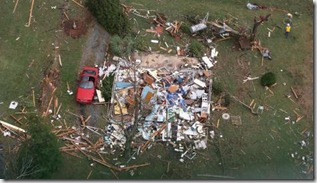Severe Weather Awareness Week Wednesday: Tornadoes
There was a statewide tornado drill today at 9:30am
Tornados are one of nature’s most violent phenomena. Tornado season typically starts in Spring in the months of March…April and May. Tornadoes have touched down in the state in all months with the largest number of tornado related fatalities occurring in March. Other months with the highest numbers of tornado related fatalities include April…May and November.
Just a few years ago a tornado outbreak affected the state on April, 16, 2011. Which was the biggest in North Carolina history. Then back in 2010 a number of tornadic thunderstorms struck the state resulting in as many as 8 strong to violent tornadoes rated on the Enhanced Fujita scale as EF-2 and higher with winds in excess of 130 mph. One such tornado occurred in Vale in Lincoln county.
 These tornadoes injured dozens of people…leaving families homeless and resulted in over 3 million dollars in damages. A number
These tornadoes injured dozens of people…leaving families homeless and resulted in over 3 million dollars in damages. A number
of tornadoes struck at night as everyone slept catching many individuals off guard despite warning lead times averaging 20 minutes. These night time monsters have a history of being particularly deadly in North Carolina.
…Tornado Dangers…
A study of tornadoes found that North Carolina was ranked first in The nation with the greatest percentage of people killed by night time tornadoes. Of all the tornado fatalities since 1950, eighty-two percent of tornado fatalities in North Carolina have occurred at night. Compare this with the fact that only about twenty-eight percent of all tornadoes actually touch down at night. A potential reason for the is high fatality rates in comparison to high-risk areas like tornado alley could be the prevalence of night time tornadoes in March, May and November. The stronger tornadoes tend to strike during these three months. Tornadoes are difficult to visually identify at night by both the public and trained spotters. Even when warnings are provided at night, people sleep at home are less likely to hear those warnings. In addition, residents have a tendency to be in more vulnerable housing and building structures (e.g., mobile or manufactured and single family homes) during the night in comparison to safer locations (e.g., school or place of work in steel or reinforced-concrete buildings) during the day. Whether at home or work remember when proper planning and action come together lives are saved.
Tornadoes are difficult to visually identify at night by both the public and trained spotters. Even when warnings are provided at night, people sleep at home are less likely to hear those warnings. In addition, residents have a tendency to be in more vulnerable housing and building structures (e.g., mobile or manufactured and single family homes) during the night in comparison to safer locations (e.g., school or place of work in steel or reinforced-concrete buildings) during the day. Whether at home or work remember when proper planning and action come together lives are saved.
…Tornado Safety…
Most tornado deaths and injuries across the state have occurred outdoors…in automobiles…and mobile homes. When a tornado warning is issued for your area or if you spot a tornado…seek shelter in a substantial building. The safest place is in an interior bathroom or closet. Put as many walls between you and the outside as possible. Stay away from windows as debris picked up by a tornado can easily shatter a window and enter your house. If you are caught outdoors…seek shelter in a low spot like a ditch or culvert. You want to get as low as possible to protect yourself from all of the flying debris in a tornado. The debris within the tornado is what causes nearly all of the injuries and deaths. If in your car and threatened by a tornado…abandon your vehicle and seek shelter in a substantial structure or in a ditch. Never try to outrun a tornado in a vehicle. Tornadoes do not travel in straight
lines and it can be very difficult to determine what direction the tornado is moving.
Also never seek shelter from a tornado under an overpass. There is no safe place under and overpass. In fact seeking shelter under an overpass puts you more at risk from violent winds and flying debris. The National Weather Service will issue tornado watches when conditions are favorable for thunderstorms to produce tornadoes. Once a tornado is spotted or detected by radar…the National
Weather Service will issue a tornado warning. Any time a tornado warning is issued for your area…take action to protect your life as well as the lives of your family.


